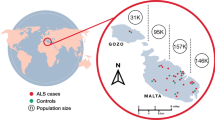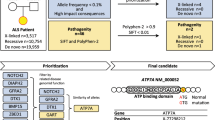Abstract
Amyotrophic lateral sclerosis (ALS) is a devastating neurodegenerative disease whose causes are still poorly understood. To identify additional genetic risk factors, we assessed the role of de novo mutations in ALS by sequencing the exomes of 47 ALS patients and both of their unaffected parents (n = 141 exomes). We found that amino acid–altering de novo mutations were enriched in genes encoding chromatin regulators, including the neuronal chromatin remodeling complex (nBAF) component SS18L1 (also known as CREST). CREST mutations inhibited activity-dependent neurite outgrowth in primary neurons, and CREST associated with the ALS protein FUS. These findings expand our understanding of the ALS genetic landscape and provide a resource for future studies into the pathogenic mechanisms contributing to sporadic ALS.
This is a preview of subscription content, access via your institution
Access options
Subscribe to this journal
Receive 12 print issues and online access
$209.00 per year
only $17.42 per issue
Buy this article
- Purchase on SpringerLink
- Instant access to full article PDF
Prices may be subject to local taxes which are calculated during checkout


Similar content being viewed by others
References
Andersen, P.M. & Al-Chalabi, A. Clinical genetics of amyotrophic lateral sclerosis: what do we really know? Nat. Rev. Neurol. 7, 603–615 (2011).
Sreedharan, J. et al. TDP-43 mutations in familial and sporadic amyotrophic lateral sclerosis. Science 319, 1668–1672 (2008).
Vance, C. et al. Mutations in FUS, an RNA processing protein, cause familial amyotrophic lateral sclerosis type 6. Science 323, 1208–1211 (2009).
Kwiatkowski, T.J. et al. Mutations in the FUS/TLS gene on chromosome 16 cause familial amyotrophic lateral sclerosis. Science 323, 1205–1208 (2009).
Johnson, J.O. et al. Exome sequencing reveals VCP mutations as a cause of familial ALS. Neuron 68, 857–864 (2010).
Maruyama, H. et al. Mutations of optineurin in amyotrophic lateral sclerosis. Nature 465, 223–226 (2010).
Deng, H.X. et al. Mutations in UBQLN2 cause dominant X-linked juvenile and adult-onset ALS and ALS/dementia. Nature 477, 211–215 (2011).
Wu, C.H. et al. Mutations in the profilin 1 gene cause familial amyotrophic lateral sclerosis. Nature 488, 499–503 (2012).
DeJesus-Hernandez, M. et al. Expanded GGGGCC hexanucleotide repeat in noncoding region of C9ORF72 causes chromosome 9p-linked FTD and ALS. Neuron 72, 245–256 (2011).
Renton, A.E. et al. A hexanucleotide repeat expansion in C9ORF72 is the cause of chromosome 9p21-linked ALS-FTD. Neuron 72, 257–268 (2011).
Rosen, D.R. et al. Mutations in Cu/Zn superoxide dismutase gene are associated with familial amyotrophic lateral sclerosis. Nature 362, 59–62 (1993).
O'Roak, B.J. et al. Sporadic autism exomes reveal a highly interconnected protein network of de novo mutations. Nature 485, 246–250 (2012).
Neale, B.M. et al. Patterns and rates of exonic de novo mutations in autism spectrum disorders. Nature 485, 242–245 (2012).
Sanders, S.J. et al. De novo mutations revealed by whole-exome sequencing are strongly associated with autism. Nature 485, 237–241 (2012).
Iossifov, I. et al. De novo gene disruptions in children on the autistic spectrum. Neuron 74, 285–299 (2012).
Xu, B. et al. Exome sequencing supports a de novo mutational paradigm for schizophrenia. Nat. Genet. 43, 864–868 (2011).
Girard, S.L. et al. Increased exonic de novo mutation rate in individuals with schizophrenia. Nat. Genet. 43, 860–863 (2011).
Vissers, L.E. et al. A de novo paradigm for mental retardation. Nat. Genet. 42, 1109–1112 (2010).
Alexander, M.D. et al. “True” sporadic ALS associated with a novel SOD-1 mutation. Ann. Neurol. 52, 680–683 (2002).
Chiò, A. et al. A de novo missense mutation of the FUS gene in a “true” sporadic ALS case. Neurobiol. Aging 32, e23–e26 (2011).
DeJesus-Hernandez, M. et al. De novo truncating FUS gene mutation as a cause of sporadic amyotrophic lateral sclerosis. Hum. Mutat. 31, E1377–E1389 (2010).
Huang, D.W. et al. Extracting biological meaning from large gene lists with DAVID. Curr. Protoc. Bioinformatics Chapter 13, 13.11 (2009).
Ryu, H. et al. Sodium phenylbutyrate prolongs survival and regulates expression of anti-apoptotic genes in transgenic amyotrophic lateral sclerosis mice. J. Neurochem. 93, 1087–1098 (2005).
Rouaux, C. et al. Sodium valproate exerts neuroprotective effects in vivo through CREB-binding protein–dependent mechanisms, but does not improve survival in an amyotrophic lateral sclerosis mouse model. J. Neurosci. 27, 5535–5545 (2007).
Egawa, N. et al. Drug screening for ALS using patient-specific induced pluripotent stem cells. Sci. Transl. Med. 4, 145ra104 (2012).
Cudkowicz, M.E. et al. Phase 2 study of sodium phenylbutyrate in ALS. Amyotroph. Lateral Scler. 10, 99–106 (2009).
Gil, O.D., Zanazzi, G., Struyk, A.F. & Salzer, J.L. Neurotrimin mediates bifunctional effects on neurite outgrowth via homophilic and heterophilic interactions. J. Neurosci. 18, 9312–9325 (1998).
van Horck, F.P., Lavazais, E., Eickholt, B.J., Moolenaar, W.H. & Divecha, N. Essential role of type I(alpha) phosphatidylinositol 4-phosphate 5-kinase in neurite remodeling. Curr. Biol. 12, 241–245 (2002).
Aizawa, H. et al. Dendrite development regulated by CREST, a calcium-regulated transcriptional activator. Science 303, 197–202 (2004).
Qiu, Z. & Ghosh, A. A calcium-dependent switch in a CREST-BRG1 complex regulates activity-dependent gene expression. Neuron 60, 775–787 (2008).
Wu, J.I. et al. Regulation of dendritic development by neuron-specific chromatin remodeling complexes. Neuron 56, 94–108 (2007).
Kabashi, E. et al. Gain and loss of function of ALS-related mutations of TARDBP (TDP-43) cause motor deficits in vivo. Hum. Mol. Genet. 19, 671–683 (2010).
Khavari, P.A., Peterson, C.L., Tamkun, J.W., Mendel, D.B. & Crabtree, G.R. BRG1 contains a conserved domain of the SWI2/SNF2 family necessary for normal mitotic growth and transcription. Nature 366, 170–174 (1993).
Fujii, R. et al. The RNA binding protein TLS is translocated to dendritic spines by mGluR5 activation and regulates spine morphology. Curr. Biol. 15, 587–593 (2005).
Cushman, M., Johnson, B.S., King, O.D., Gitler, A.D. & Shorter, J. Prion-like disorders: blurring the divide between transmissibility and infectivity. J. Cell Sci. 123, 1191–1201 (2010).
Gitler, A.D. & Shorter, J. RNA-binding proteins with prion-like domains in ALS and FTLD-U. Prion 5, 179–187 (2011).
King, O.D., Gitler, A.D. & Shorter, J. The tip of the iceberg: RNA-binding proteins with prion-like domains in neurodegenerative disease. Brain Res. 1462, 61–80 (2012).
Couthouis, J. et al. A yeast functional screen predicts new candidate ALS disease genes. Proc. Natl. Acad. Sci. USA 108, 20881–20890 (2011).
Couthouis, J. et al. Evaluating the role of the FUS/TLS-related gene EWSR1 in amyotrophic lateral sclerosis. Hum. Mol. Genet. 21, 2899–2911 (2012).
Kim, H.J. et al. Mutations in prion-like domains in hnRNPA2B1 and hnRNPA1 cause multisystem proteinopathy and ALS. Nature 495, 467–473 (2013).
Monroy, M.A. et al. Regulation of cAMP-responsive element–binding protein–mediated transcription by the SNF2/SWI-related protein, SRCAP. J. Biol. Chem. 276, 40721–40726 (2001).
Wang, X. et al. Induced ncRNAs allosterically modify RNA-binding proteins in cis to inhibit transcription. Nature 454, 126–130 (2008).
Bultman, S. et al. A Brg1 null mutation in the mouse reveals functional differences among mammalian SWI/SNF complexes. Mol. Cell 6, 1287–1295 (2000).
Tsurusaki, Y. et al. Mutations affecting components of the SWI/SNF complex cause Coffin-Siris syndrome. Nat. Genet. 44, 376–378 (2012).
Wolff, D. et al. In-frame deletion and missense mutations of the C-terminal helicase domain of SMARCA2 in three patients with Nicolaides-Baraitser syndrome. Mol. Syndromol. 2, 237–244 (2012).
Van Houdt, J.K. et al. Heterozygous missense mutations in SMARCA2 cause Nicolaides-Baraitser syndrome. Nat. Genet. 44, 445–449 (2012).
Hoyer, J. et al. Haploinsufficiency of ARID1B, a member of the SWI/SNF-a chromatin-remodeling complex, is a frequent cause of intellectual disability. Am. J. Hum. Genet. 90, 565–572 (2012).
Loe-Mie, Y. et al. SMARCA2 and other genome-wide supported schizophrenia-associated genes: regulation by REST/NRSF, network organization and primate-specific evolution. Hum. Mol. Genet. 19, 2841–2857 (2010).
Lule, D., Ludolph, A.C. & Ludolph, A.G. Neurodevelopmental and neurodegenerative diseases: is there a pathophysiological link? Attention-deficit/hyperactivity disorder and amyotrophic lateral sclerosis as examples. Med. Hypotheses 70, 1133–1138 (2008).
Calvo, A.C. et al. Genetic biomarkers for ALS disease in transgenic SOD1(G93A) mice. PLoS ONE 7, e32632 (2012).
Li, H. & Durbin, R. Fast and accurate short read alignment with Burrows-Wheeler transform. Bioinformatics 25, 1754–1760 (2009).
McKenna, A. et al. The Genome Analysis Toolkit: a MapReduce framework for analyzing next-generation DNA sequencing data. Genome Res. 20, 1297–1303 (2010).
DePristo, M.A. et al. A framework for variation discovery and genotyping using next-generation DNA sequencing data. Nat. Genet. 43, 491–498 (2011).
Hosack, D.A., Dennis, G. Jr., Sherman, B.T., Lane, H.C. & Lempicki, R.A. Identifying biological themes within lists of genes with EASE. Genome Biol. 4, R70 (2003).
Dufu, K. et al. ATP is required for interactions between UAP56 and two conserved mRNA export proteins, Aly and CIP29, to assemble the TREX complex. Genes Dev. 24, 2043–2053 (2010).
Folco, E.G., Lei, H., Hsu, J.L. & Reed, R. Small-scale nuclear extracts for functional assays of gene-expression machineries. J. Vis. Exp. 64, e4140 (2012).
Acknowledgements
This work was supported by a US National Institutes of Health Director's New Innovator Award 1DP2OD004417 (A.D.G.), grants from the US National Institutes of Health (1R01NS065317 to A.D.G., R01NS046789 to G.R.C. and 5U01NS062713 to N.J.M.) and the Department of Defense ALS Research Program (N.J.M.). A.D.G. received funding from the Biogen Idec ALS genome sequencing consortium. A.D.G. received funding from The Pew Charitable Trusts and the Rita Allen Foundation. G.R.C. receives funding from the Howard Hughes Medical Institute. A.D.G. and J.D.G. are supported by the Packard Center for ALS Research at Johns Hopkins. This work was also supported by the National Health and Medical Research Council of Australia (1004670, 511941) and the Motor Neurone Disease Research Institute of Australia.
Author information
Authors and Affiliations
Contributions
A.C. performed all of the exome sequencing and analysis. B.T.S. and A.J. performed the primary neuron experiments. B.T.S. performed co-immunoprecipitation experiments with direction from G.R.C. J.C., M.F. and A.R.R. performed Sanger sequencing and helped A.C. with exome sequencing. T.Y. and R.R. performed SS18L1-FUS physical association experiments. L.E. performed mass spectrometry analysis. N.J.M. and J.D.G. contributed ALS patient samples, with assistance from M.P. and C.K., and helped to design experiments. K.L.W., J.A.F., G.A.N. and I.P.B. contributed ALS patient samples and performed experiments to identify SS18L1 variants in Australian FALS pedigrees. O.D.K. performed prion-like domain analysis for SS18L1 and SS18. A.D.G. and A.C. wrote the manuscript with input from all of the authors.
Corresponding authors
Ethics declarations
Competing interests
The authors declare no competing financial interests.
Supplementary information
Supplementary Text and Figures
Supplementary Figures 1–3 and Supplementary Tables 1–3 (PDF 1083 kb)
Rights and permissions
About this article
Cite this article
Chesi, A., Staahl, B., Jovičić, A. et al. Exome sequencing to identify de novo mutations in sporadic ALS trios. Nat Neurosci 16, 851–855 (2013). https://doi.org/10.1038/nn.3412
Received:
Accepted:
Published:
Issue Date:
DOI: https://doi.org/10.1038/nn.3412
This article is cited by
-
Modelling amyotrophic lateral sclerosis in rodents
Nature Reviews Neuroscience (2022)
-
A postzygotic de novo NCDN mutation identified in a sporadic FTLD patient results in neurochondrin haploinsufficiency and altered FUS granule dynamics
Acta Neuropathologica Communications (2022)
-
Protein expression pattern of calcium-responsive transactivator in early postnatal and adult testes
Histochemistry and Cell Biology (2021)
-
CRISPR-mediated gene correction links the ATP7A M1311V mutations with amyotrophic lateral sclerosis pathogenesis in one individual
Communications Biology (2020)
-
Loss of CREST leads to neuroinflammatory responses and ALS-like motor defects in mice
Translational Neurodegeneration (2019)




